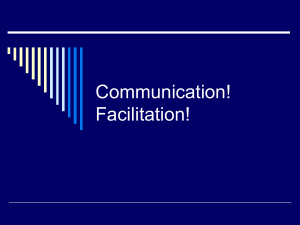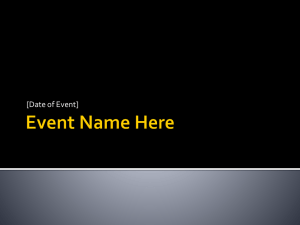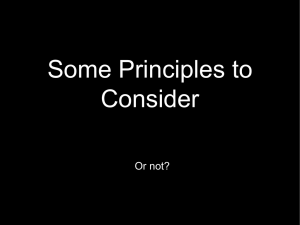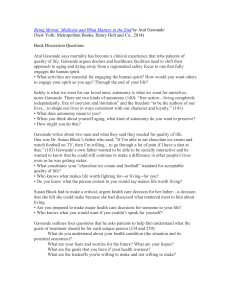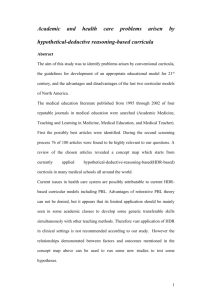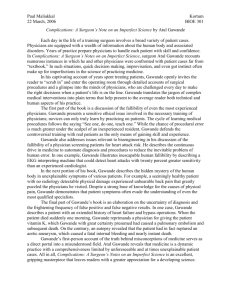Introduction to Medicine, Surgery, and Medical Education
advertisement
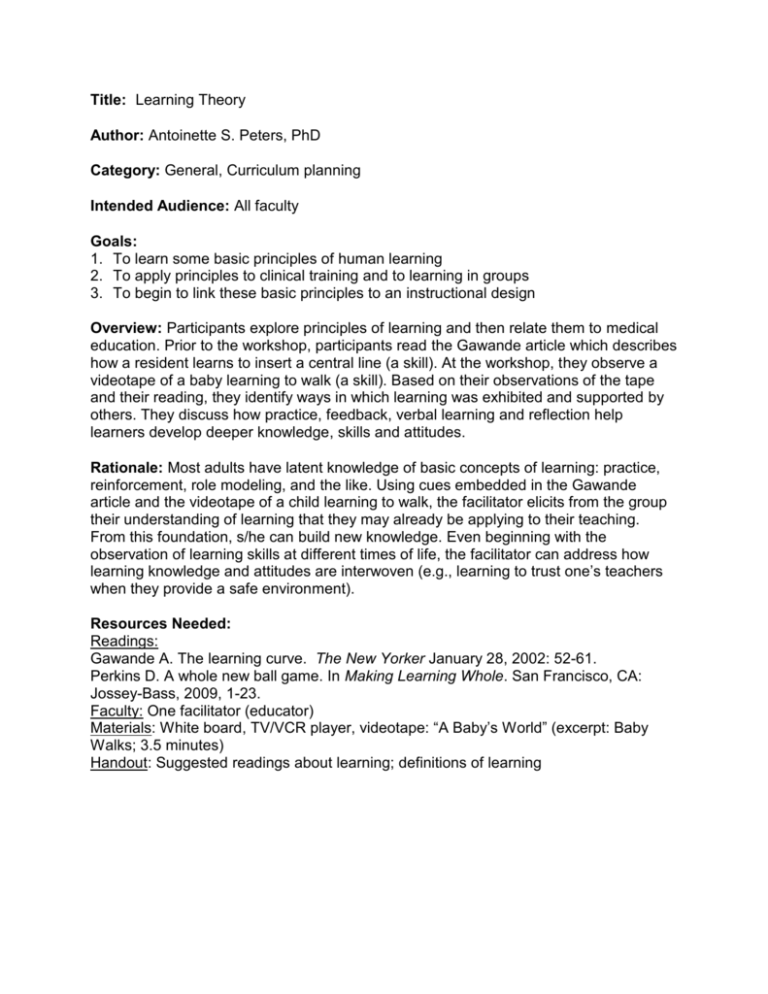
Title: Learning Theory Author: Antoinette S. Peters, PhD Category: General, Curriculum planning Intended Audience: All faculty Goals: 1. To learn some basic principles of human learning 2. To apply principles to clinical training and to learning in groups 3. To begin to link these basic principles to an instructional design Overview: Participants explore principles of learning and then relate them to medical education. Prior to the workshop, participants read the Gawande article which describes how a resident learns to insert a central line (a skill). At the workshop, they observe a videotape of a baby learning to walk (a skill). Based on their observations of the tape and their reading, they identify ways in which learning was exhibited and supported by others. They discuss how practice, feedback, verbal learning and reflection help learners develop deeper knowledge, skills and attitudes. Rationale: Most adults have latent knowledge of basic concepts of learning: practice, reinforcement, role modeling, and the like. Using cues embedded in the Gawande article and the videotape of a child learning to walk, the facilitator elicits from the group their understanding of learning that they may already be applying to their teaching. From this foundation, s/he can build new knowledge. Even beginning with the observation of learning skills at different times of life, the facilitator can address how learning knowledge and attitudes are interwoven (e.g., learning to trust one’s teachers when they provide a safe environment). Resources Needed: Readings: Gawande A. The learning curve. The New Yorker January 28, 2002: 52-61. Perkins D. A whole new ball game. In Making Learning Whole. San Francisco, CA: Jossey-Bass, 2009, 1-23. Faculty: One facilitator (educator) Materials: White board, TV/VCR player, videotape: “A Baby’s World” (excerpt: Baby Walks; 3.5 minutes) Handout: Suggested readings about learning; definitions of learning Protocol: (90 minutes) Introduction and goal setting (15 minutes) The facilitator assesses the group’s prior experience with formal education in learning theory. S/he asks members of the group to define learning, and writes their definitions on the board. S/he notes that there is no one agreed upon definition of learning, but most definitions include the concept of change. S/he then reads one or two psychologists’ definitions of learning. S/he explains that they have undoubtedly accrued an understanding of learning over the years, even if they are not aware of a formal knowledge of theories; and, therefore, s/he will elicit that latent knowledge during the next exercise. Video (5 minutes) Watch video of child learning to walk Facilitated discussion (30 minutes) To elicit general principles, the facilitator asks: What principles are exhibited? How do they relate to the principles exhibited in the Gawande article? What kinds of learning are occurring (e.g., a knowledge, skill and/or attitude)? It is likely the following principles will emerge from the discussion; however, if participants don’t mention them spontaneously, the facilitator should probe for each one: motivation, modeling; safe environment; practice; reinforcement; visual memory; verbal versus nonverbal learning and how that relates to memory; recall. Summary (10 minutes) The facilitator makes a brief presentation of learning theory, summarizing and expanding upon the principles s/he elicited during the prior discussion. S/he highlights two theories – constructivism and social learning theory – because medical faculty are most familiar with these. In this presentation, the facilitator notes the following: a. Learning occurs through a triadic interaction of personal characteristics, the environment and behavior (e.g., the baby is healthy and sufficiently mature to learn to walk, the environment is safe and inviting, and his mother reinforces and encourages his behavior). Therefore, learning is social and grounded in one’s environment. b. Learning is constructed, based on prior knowledge and skills that are elaborated with successive experiences (e.g., the resident’s knowledge of anatomy is the foundation for understanding where the central line will go within the body). c. Different kinds of learning – verbal learning, attitudes, manual skills – require different approaches, which is important for teachers to understand. d. In summary: One needs to consider the motivation to learn and the opportunity to learn within a given environment; the learning experience during which encoding of new knowledge occurs; how memories are formed (e.g., visually, abstractly) and connected appropriately with prior knowledge that one recalls easily; how what is learned will be recalled, practiced and applied. Curriculum planning (30 minutes) Depending upon the extent of homogeneity of interests within the group, this exercise varies. A homogenous group undertakes designing a teaching session together, whereas heterogeneous groups work in dyads or triads to design different kinds of lessons. Nonetheless, the group identifies a concept or skill that it wants to teach its students and then discusses (a) how initial learning will occur; (b) how learning will occur over time to assure retention; and (c) what the implications are for teaching this concept or skill. Summary and conclusion (15 minutes) Together, the group discusses with the facilitator the challenges they encountered in designing a piece of curriculum, whether in applying learning theory or in determining appropriate teaching methods. HANDOUT SUGGESTED READINGS ABOUT LEARNING If you would like to read about how learning theory applies to medical education, see: 1. Gruppen LD. Implications of cognitive research for ambulatory care education. Acad Med. 1997;72:117-120. 1. Hewson MG. Clinical teaching in the ambulatory setting. JGIM 1992;7:76-82. 2. Knowles MS, Holton EF, Swanson RA. The Adult Learner (5th Ed.) Houston, TX: Gulf Publ. Co., 1998. 3. Mann KV. Educating medical students: lessons from research in continuing education. Acad Med. 1994;69:41-47. 4. Martenson D. Learning: current knowledge and the future. Medical Teacher 2001;23:192-197. 5. Norman GR, Schmidt HG. The psychological basis of problem-based learning: a review of the evidence. Acad Med. 1992;67:557-65. 6. Norman G. Research in clinical reasoning: past history and current trends. Med Educ. 2005;39:418-27. 7. Regehr G, Norman GR. Issues in cognitive psychology: implications for professional education. Acad Med. 1996;71:988-1001. 8. TenCate O, Snell L, Mann K, Vermunt J. Orienting teaching toward the learning process. Acad Med. 2004;79:219-28. 9. Wilkerson L. Learning in a clinical setting. In To Improve the Academy. Pp 12033. Good general readings about learning include: 1. Schacter DL. The seven sins of memory: Insights from psychology and cognitive neuroscience. American Psychologist 1999;54:182-203. 2. Merriam SB, Caffarella RS. Key theories of learning. In Learning in Adulthood. (2nd Ed) San Francisco: Jossey-Bass, 1999, pp 248-66. 3. Perkins D. Making Learning Whole. San Francisco: Jossey-Bass, 2009. HANDOUT DEFINITIONS OF LEARNING “Learning is the act or process by which behavioral change, knowledge, skills, and attitudes are acquired.” (Boyd et al, 1980) “Learning is a change in the individual, due to the interaction of that individual and his environment which fills a need and makes him more capable of dealing adequately with his environment.” (Burton, 1963) DOMAINS OF LEARNING Motor skills: developed through practice Verbal information: learned within a meaningful context Intellectual skills: built upon prior learning Cognitive strategies: developed through repeated challenges to one’s thinking Attitudes: learned through human models (Gagne, 1972) ASSUMPTIONS ABOUT ADULT LEARNERS Adults are motivated to learn as they experience needs/interests that learning satisfies. Adults’ orientation to learning is life-centered. Experience is the richest source for adults’ learning. Adults have a deep need to be self-directing. Individual differences among people increase with age. Adults’ motivation to learn is more often driven by internal rather than external forces. (Knowles et al., 1998)


